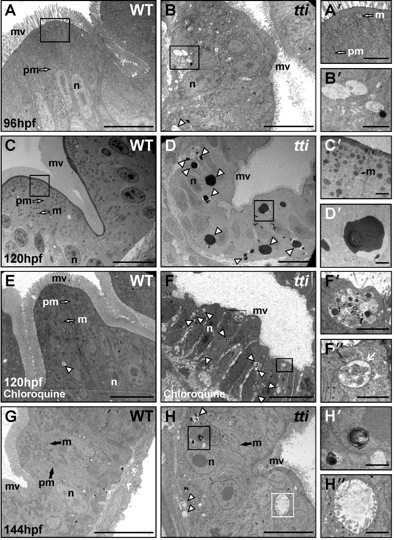Fig. 4
(A–H) Transmission electron micrographs of WT and ttis450 larvae at 96 hpf (A, B), 120 hpf (C–F) and 144 hpf (G, H). Sections are transverse through the yolk in the region of the intestinal bulb. WT IECs demonstrate well-developed apicobasal polarity as evidenced by basally positioned nuclei (n) and the elaboration of microvilli (mv) projecting from the apical surface into the intestinal lumen. Mitochondria (m) are abundant and plasma membranes (pm) are well defined. The intestinal epithelium in ttis450 is highly disorganized, with shorter and relatively sparse apical microvilli compared to WT. Vesicles resembling autophagosomes (white arrowhead in B) are present in the intestinal epithelial cells of ttis450 larvae (B′ [boxed area in B], H′′ [boxed area in H]) but not in WT (A, A2 [boxed area in A] and G). At 120 hpf, electron-dense structures, likely to correspond to autolysosomes, are present in ttis450 larvae (white arrowheads in D, D′ [boxed area in D]), but not WT (C, C′ [boxed area in C]). When ttis450 larvae are treated with chloroquine to block the fusion of autophagosomes with lysosomes, the electron-dense structures are no longer apparent at 120 hpf; instead vesicles more typical of autophagosomes are found (white arrowheads in F). The boxed areas in F (F′ and F′′) show vesicles containing debris, including one (white arrow in F′′), with a clear double membrane. Scale bars = 10 μm (A–H) and 1 μm (all insets).

